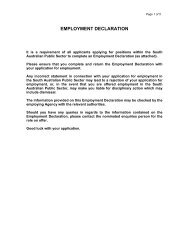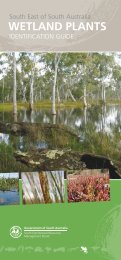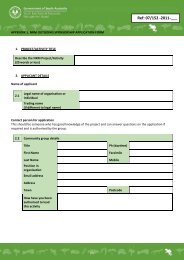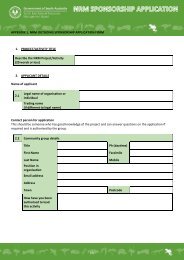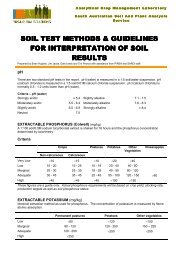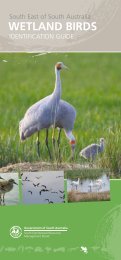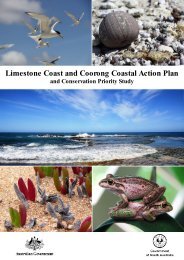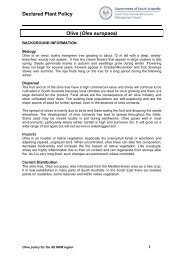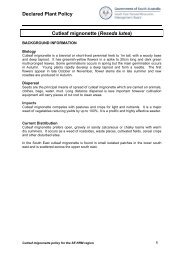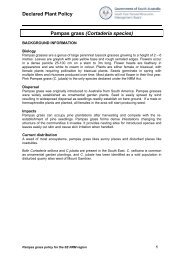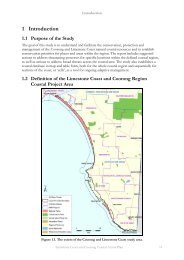Cell Descriptions - South East Natural Resources Management Board
Cell Descriptions - South East Natural Resources Management Board
Cell Descriptions - South East Natural Resources Management Board
Create successful ePaper yourself
Turn your PDF publications into a flip-book with our unique Google optimized e-Paper software.
SE5 – Carpenters Rocks<br />
high threats primarily from ownership, use and zoning. This analysis is a strong argument for a<br />
raised level of protection for these small patches.<br />
The pattern of development zoning raises a related issue: as to whether primary industry is an<br />
appropriate zoning for a conservation park and a game reserve and heritage agreement land.<br />
Adaptation to Climate Change: Threats for <strong>Cell</strong> SE5<br />
(see also discussion of scenario in Section 4.11<br />
NOTE: the advice below is indicative of likely change and the direction of change, with<br />
implications for ecosystems. Dates, amounts and probabilities cannot be accurately calculated at<br />
this time. Thus advice on flood levels, for example, should not be used in engineering or<br />
development planning.<br />
Climate change<br />
element/ scenario<br />
Combined climate<br />
changes and sea<br />
level rise<br />
throughout this<br />
cell<br />
Sea level rise:<br />
2030 : +c.20cm<br />
2070: +c.80cm.<br />
Storms:<br />
Frequency continues<br />
to show great<br />
variation on a<br />
decadal scale.<br />
Intensity of large<br />
Impacts and implications Protect and manage Address landscape<br />
(for this cell) habitat threats issues: fire,<br />
connectivity,<br />
refuges, hydrology<br />
This cell presents a complex<br />
pattern of habitats sensitive<br />
to change.<br />
Rise in frequency of tidal<br />
flooding, threatens low land<br />
at Bungaloo Bay.<br />
Increase in storm foredune<br />
damage and beach recession<br />
in embayments, here, beach<br />
change may be rapid,<br />
because of low storage<br />
volumes of sand. Very low<br />
to non-existent dune<br />
elevations threaten surge<br />
overtopping, and rapid<br />
shoreline recession.<br />
Beach and nearshore sand<br />
accumulation in lee of reefs<br />
may be reduced together<br />
with reef protection of the<br />
shore. This creates the<br />
potential for rapid shoreline<br />
change at Cape Banks<br />
Lighthouse and Pelican<br />
Point.<br />
2030: Occasional storm tide<br />
flooding above highest<br />
known tides.<br />
2070: Flooding will affect all<br />
swamps and adjacent low<br />
lying areas. Low land<br />
backing Bungaloo Bay<br />
appears vulnerable. <strong>Natural</strong><br />
Create a baseline for<br />
shoreline, dune and lake<br />
change by establishing a<br />
rectified aerial<br />
photographic record at<br />
an appropriate<br />
resolution.<br />
Monitor storm tide<br />
impacts.<br />
Establish beach profile<br />
monitoring at Bungaloo<br />
Bay, Bucks Bay and<br />
Lighthouse Bay, as<br />
baseline information for<br />
coastal change.<br />
Maintain aerial imagery<br />
record to track shoreline<br />
changes.<br />
Ongoing adaptive<br />
management of the sill<br />
on the Lake Bonney<br />
connection.<br />
Limestone Coast and Coorong Coastal Action Plan 277



